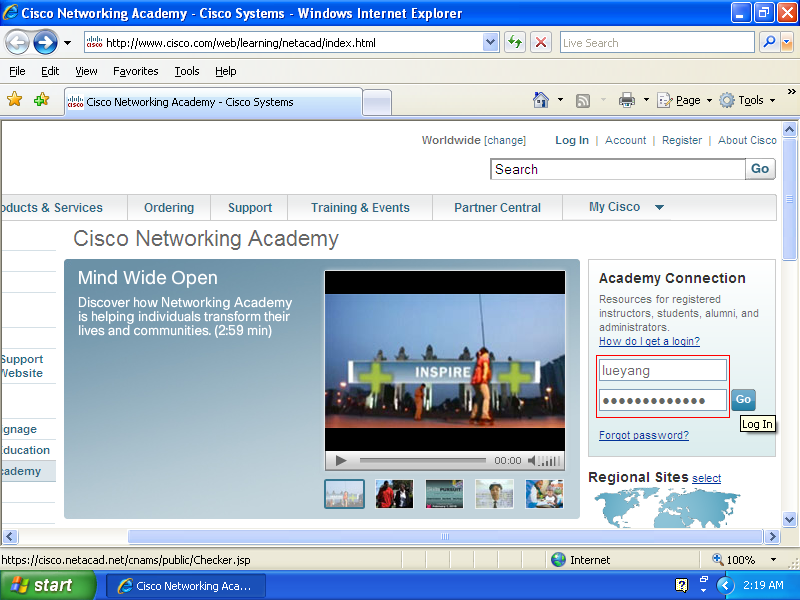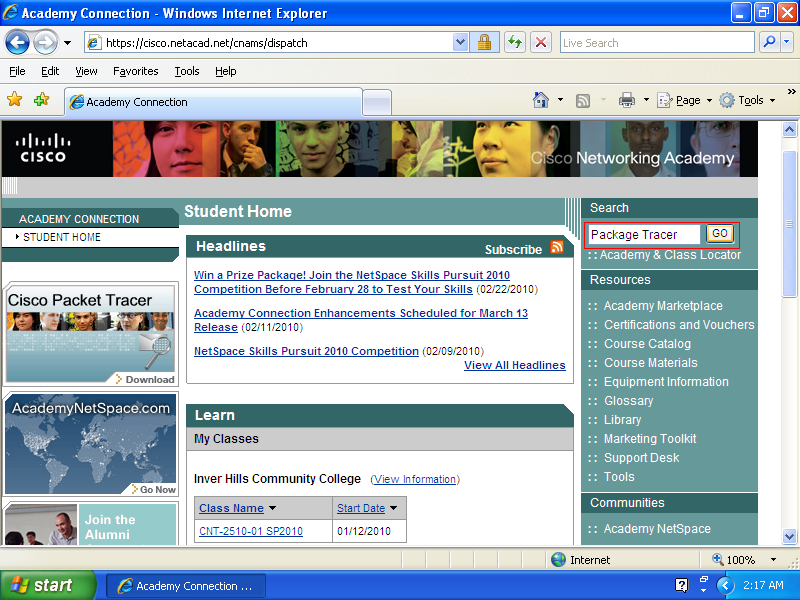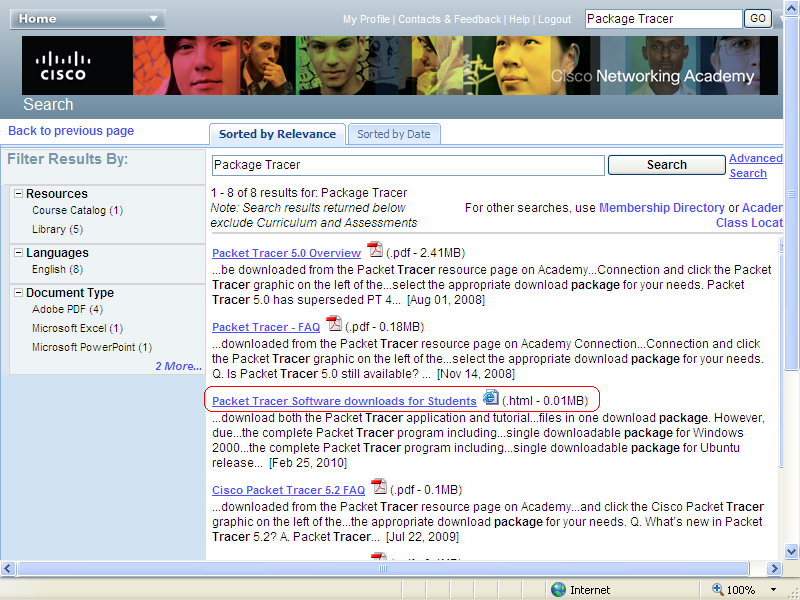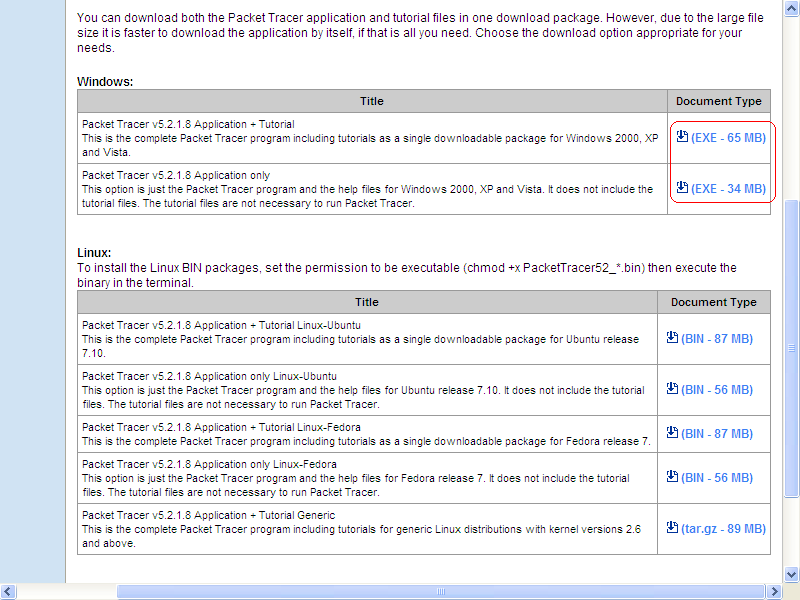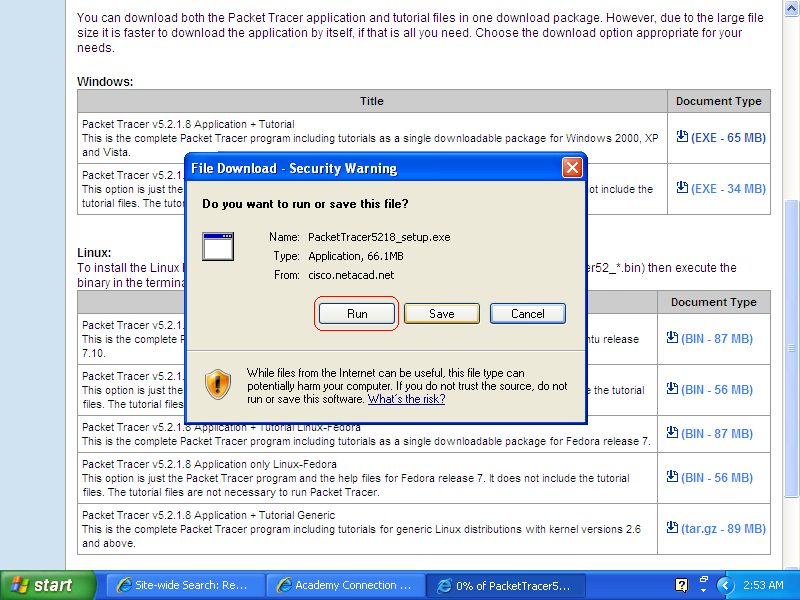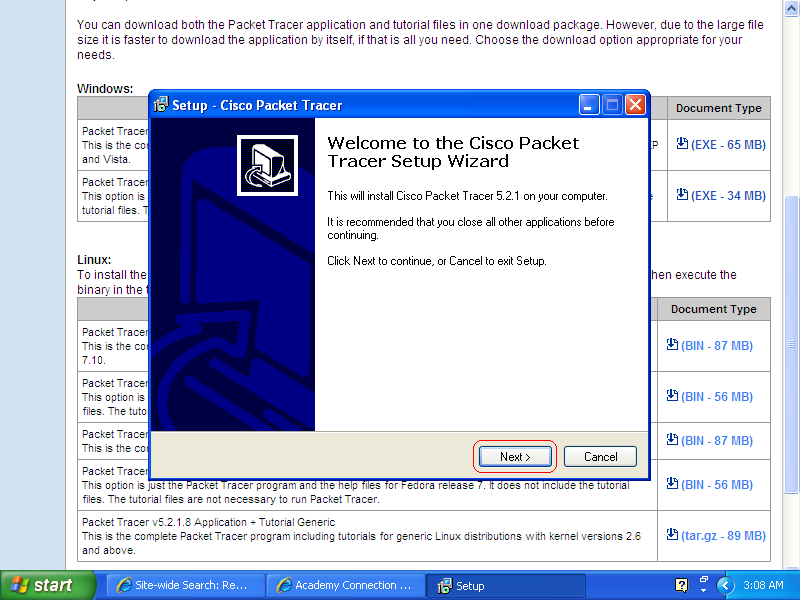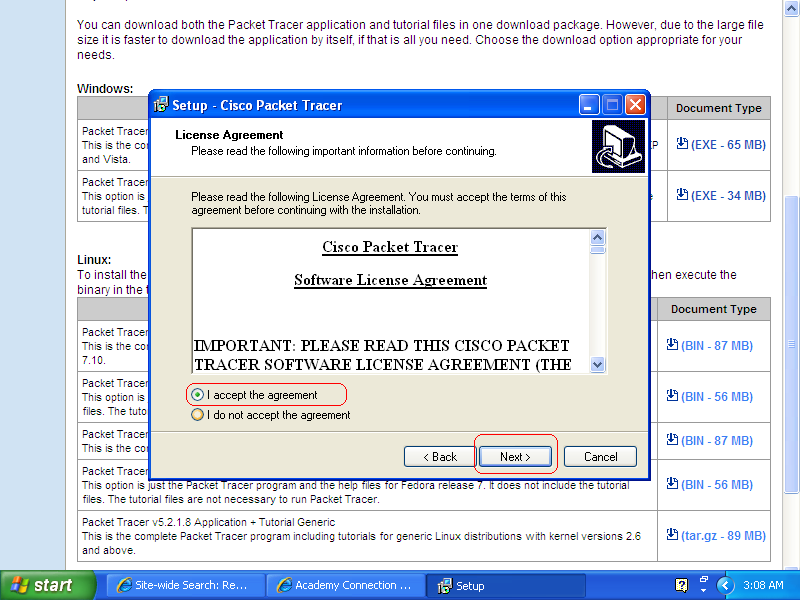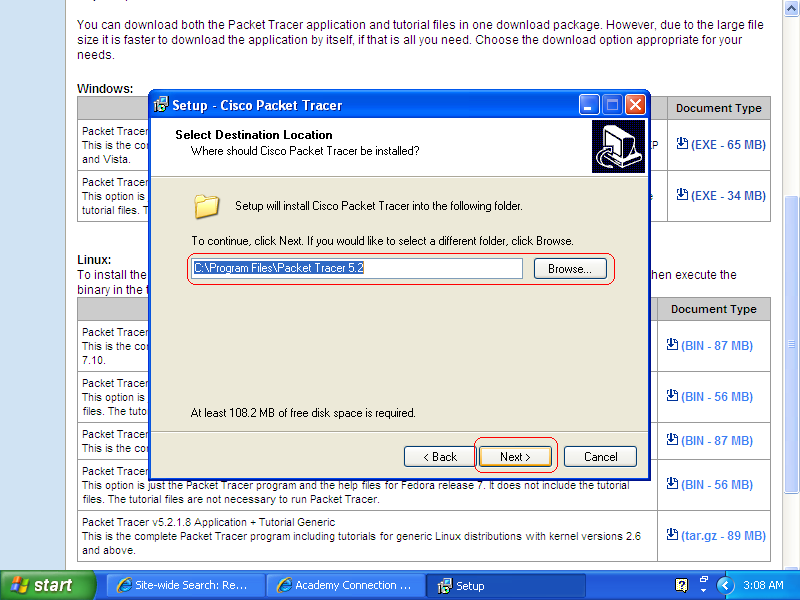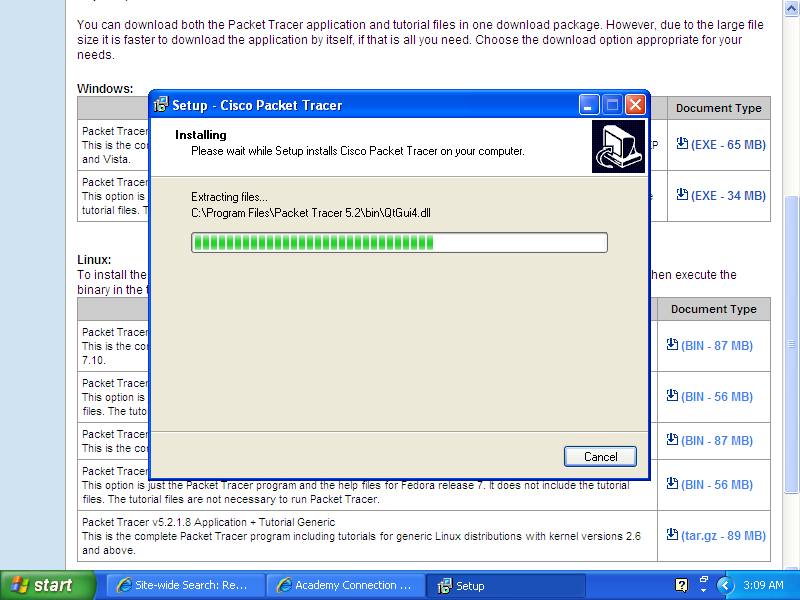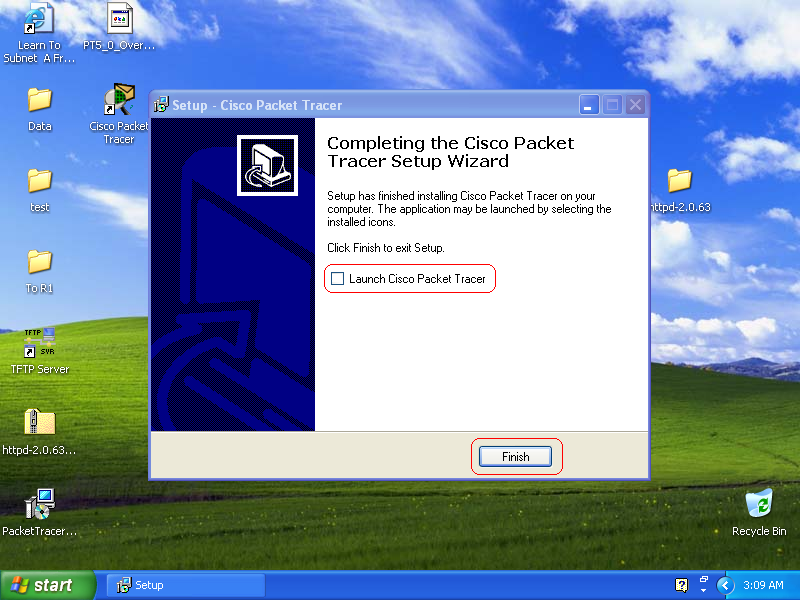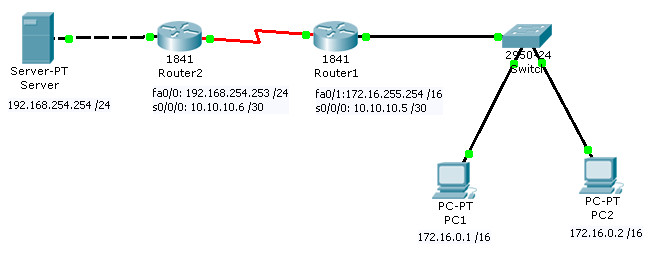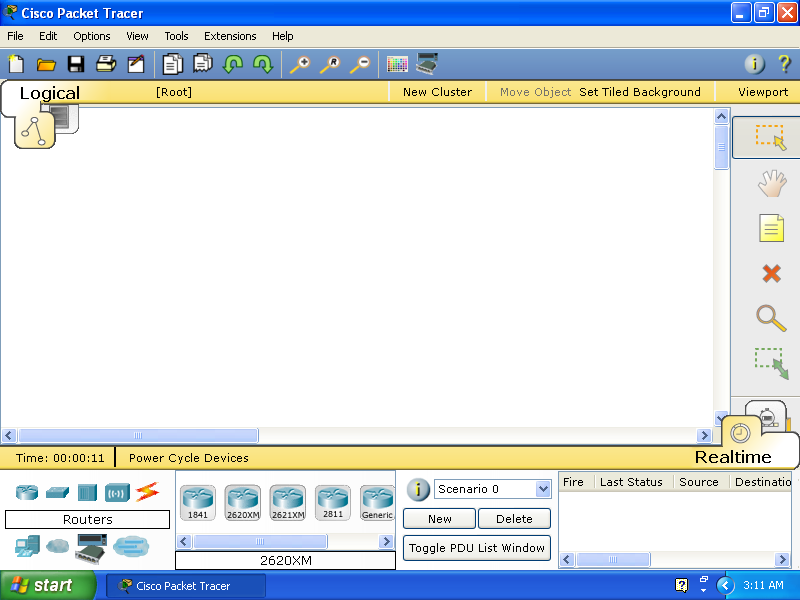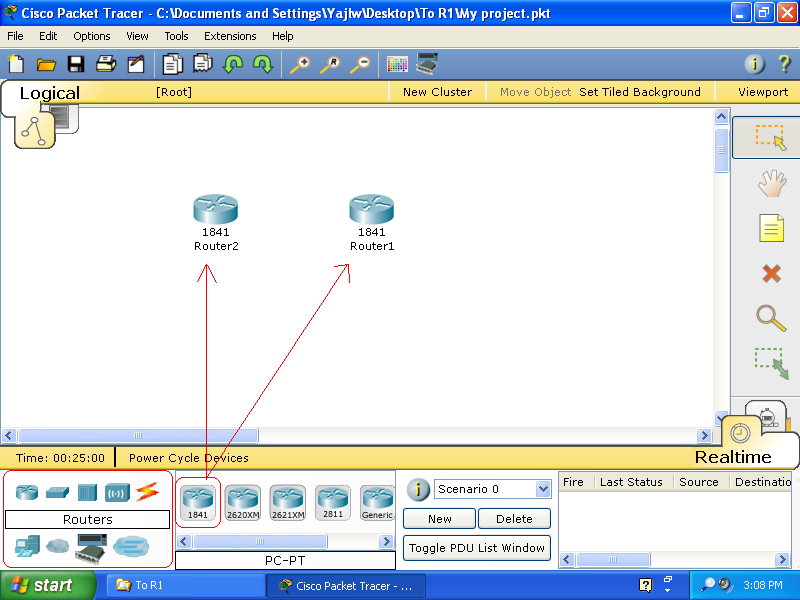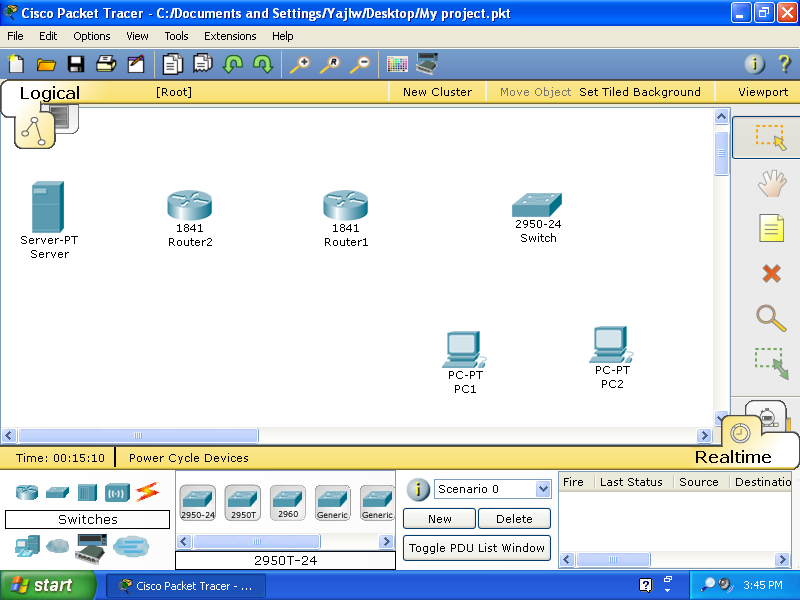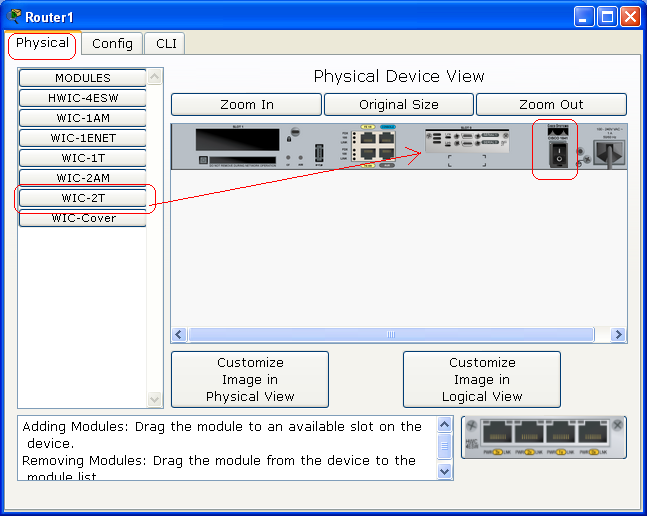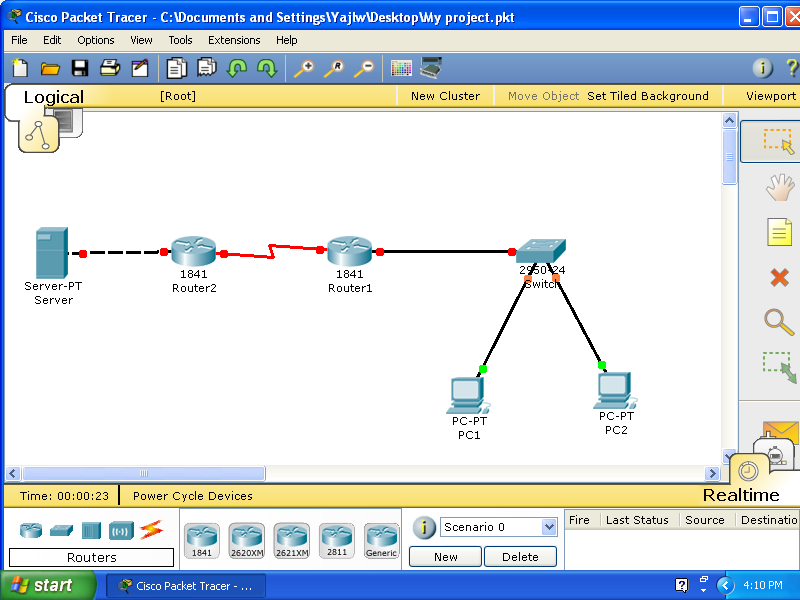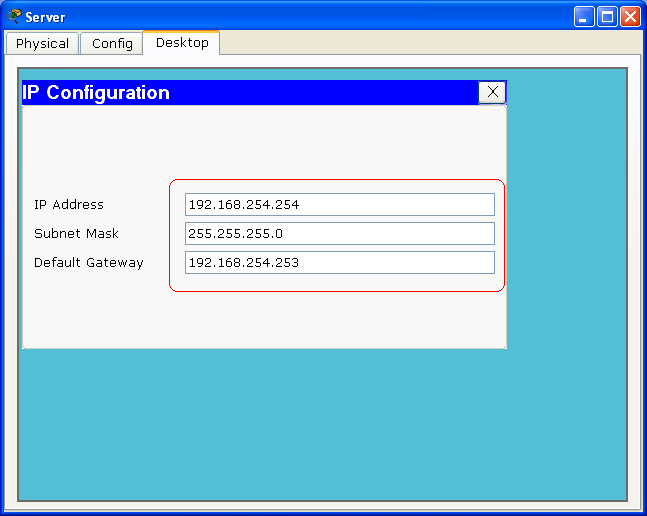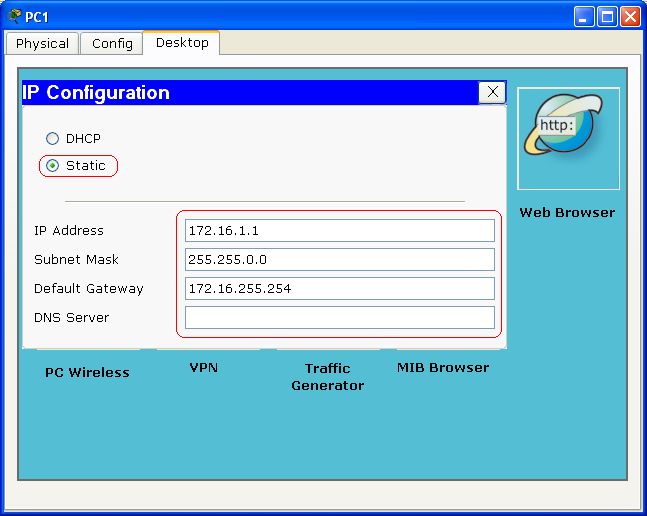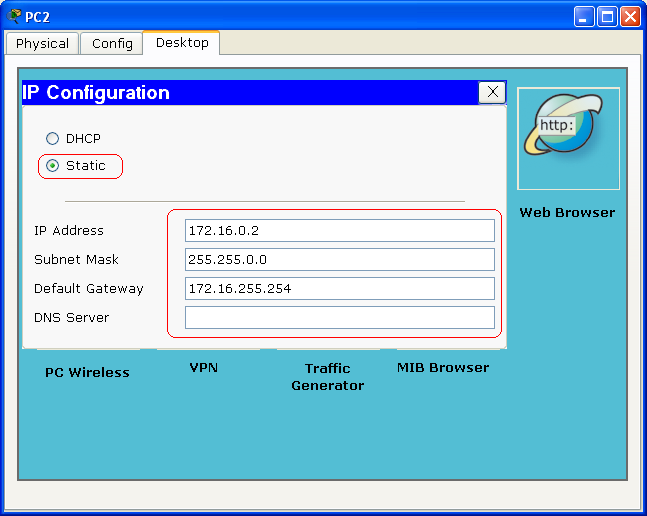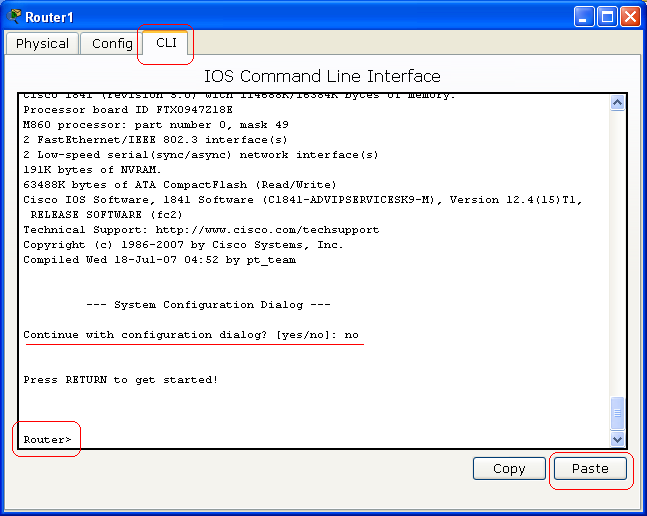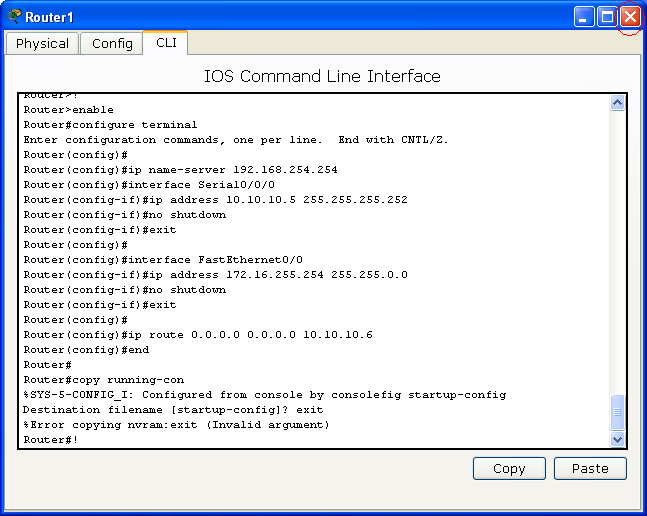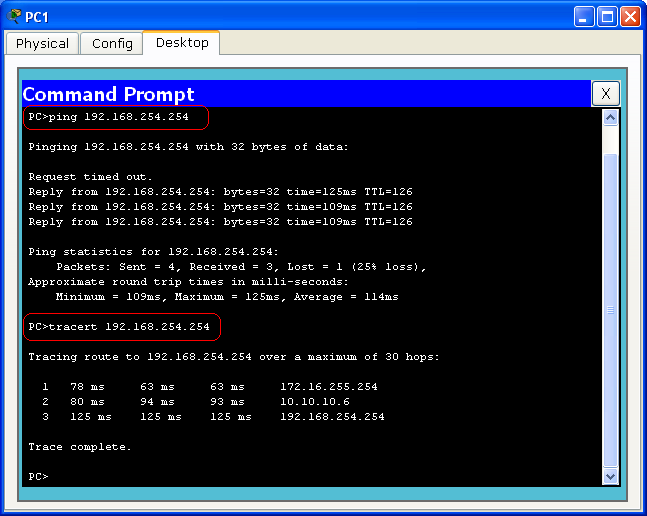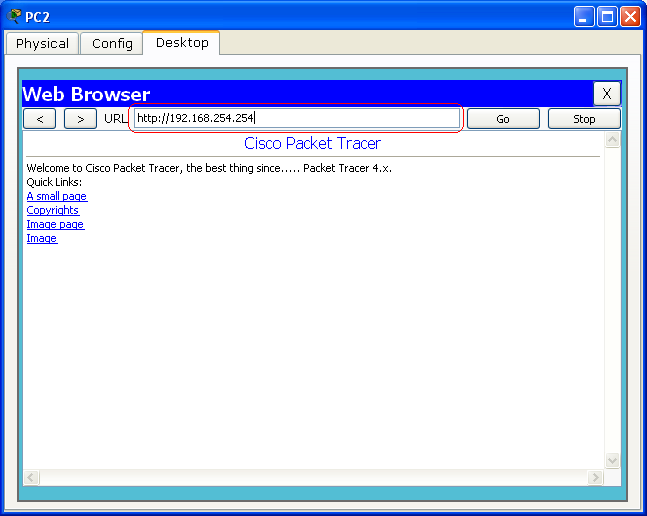Packet Tracer Instructions: Difference between revisions
No edit summary |
|||
| Line 9: | Line 9: | ||
===How to download=== | ===How to download=== | ||
*Step 1 | *'''Step 1''' | ||
[http://cisco.netacad.net Go to Cisco Networking Academy home page] | [http://cisco.netacad.net Go to Cisco Networking Academy home page] | ||
| Line 15: | Line 15: | ||
*Step 2 | *'''Step 2''' | ||
Login onto the Student Home using your username and password. | Login onto the Student Home using your username and password. | ||
| Line 21: | Line 21: | ||
*Step 3 | *'''Step 3 | ||
On the Student Home page, type '''Package Tracer''' in the search box and press '''GO''' or Enter key to search for the software. | '''On the Student Home page, type '''Package Tracer''' in the search box and press '''GO''' or Enter key to search for the software. | ||
[[File:pkt02.PNG|800px]] | [[File:pkt02.PNG|800px]] | ||
| Line 28: | Line 28: | ||
*Step 4 | *'''Step 4''' | ||
Scroll down to find '''Packet Tracer Software downloads for Students (.html - 0.01MB)'''. Click on the link and a new windows will prompt. | Scroll down to find '''Packet Tracer Software downloads for Students (.html - 0.01MB)'''. Click on the link and a new windows will prompt. | ||
| Line 34: | Line 34: | ||
*Step 5 | *'''Step 5''' | ||
To download, click '''(EXE - 34 MB)''', or (EXE - 65 MB) if you want to include tutorials in a single package. | To download, click '''(EXE - 34 MB)''', or (EXE - 65 MB) if you want to include tutorials in a single package. | ||
| Line 44: | Line 44: | ||
---- | ---- | ||
*Step 1 | To install Cisco Package Tracer, follow the step bellow: | ||
*'''Step 1''' | |||
And, then click '''Run''' to run the installation process after downloaded. | And, then click '''Run''' to run the installation process after downloaded. | ||
| Line 52: | Line 54: | ||
The screen shots below will show you through each step of the installation process. | The screen shots below will show you through each step of the installation process. | ||
*Step 2 | *'''Step 2''' | ||
Click next | Click next | ||
| Line 58: | Line 60: | ||
*Step 3 | *'''Step 3''' | ||
In oder to install the software, you must check '''I accept the agreement''' and click the '''Next''' button. | In oder to install the software, you must check '''I accept the agreement''' and click the '''Next''' button. | ||
| Line 64: | Line 66: | ||
*Step 4 | *'''Step 4''' | ||
Click the '''Next''' button. | Click the '''Next''' button. | ||
| Line 72: | Line 74: | ||
*Step 5 | *'''Step 5''' | ||
Click the Finish button. | Click the Finish button. | ||
| Line 91: | Line 93: | ||
===Building Cisco equipment and hardware=== | ===Building Cisco equipment and hardware=== | ||
Follow the bellow | Follow the steps bellow to create the network base on the topology above. | ||
*Step 1 | *'''Step 1''' | ||
Double click the '''Cisco Package Tracer''' icon on the desktop, the Cisco Package Tracer windows will open as shown below: | Double click the '''Cisco Package Tracer''' icon on the desktop, the Cisco Package Tracer windows will open as shown below: | ||
| Line 101: | Line 103: | ||
*Step 2 | *'''Step 2''' | ||
To create the '''Routers''' icon locates on the bellow left-hand conner, then click on the models that appear next to the right. Click and draft the model you want to the work area. Click the name of the routers to change them if you want. | To create the '''Routers''' icon locates on the bellow left-hand conner, then click on the models that appear next to the right. Click and draft the model you want to the work area. Click the name of the routers to change them if you want. | ||
| Line 108: | Line 110: | ||
*Step 3 | *'''Step 3''' | ||
Click the the '''Switches''' icon, and then click and draft the model you want to the work area. | Click the the '''Switches''' icon, and then click and draft the model you want to the work area. | ||
| Line 117: | Line 119: | ||
*Step 5 | *'''Step 5''' | ||
Click on Router1, under '''Physical''' tab, you will see the physical device picture under Physical Device View. turn it off, and then click and draft the modules '''WIC-2T''' to one of the expansion slots of the router, and then turn it on. | Click on Router1, under '''Physical''' tab, you will see the physical device picture under Physical Device View. turn it off, and then click and draft the modules '''WIC-2T''' to one of the expansion slots of the router, and then turn it on. | ||
| Line 130: | Line 132: | ||
---- | ---- | ||
To connect all the devices together, click the '''Connection''' icon, and then click the right cable. | To connect all the devices together, click the '''Connection''' icon, and then click the cable icon next to the right to choose the right cable. | ||
*('''Note''')Make sure to use the right cables. | *('''Note''')Make sure to use the right cables. | ||
| Line 285: | Line 288: | ||
[[file:pkt22.png|647px]] | [[file:pkt22.png|647px]] | ||
There are several methods to test network connectivity. However, I will not walk you through all the methods. Up to this point, you should know the basic operation of Cisco Package Tracer, and be able to build your own network. | |||
Enjoy! | |||
--[[User:Lueyang|Lueyang]] 02:06, 1 March 2010 (UTC) | |||
Revision as of 02:06, 1 March 2010
Package Tracer Instructions
Cisco Packet Tracer is a powerful network simulation program that allows us to create a network with an almost unlimited number of devices, encouraging practice, discovery, and troubleshooting. The main objective of Packet Tracer is to serve as a support tool for the Cisco Academy. This tool is extremely useful for both students and teachers. In this page, I will walk you through step by step of how to download, install and build a network lab that we use in the CCNA1 using Package Tracer. This instruction is best for a student who have an account to login to the Cisco Networking Academy home page.
Downloading & Installing Package Tracer
Packet Tracer 5.2 is the latest version of Cisco's simulation software available. To download Package Tracer, follow the instruction below:
How to download
- Step 1
Go to Cisco Networking Academy home page
(NOTE: Make sure to hold Ctrl key to open the link in a new tab.)
- Step 2
Login onto the Student Home using your username and password.
- Step 3
On the Student Home page, type Package Tracer in the search box and press GO or Enter key to search for the software.
- Step 4
Scroll down to find Packet Tracer Software downloads for Students (.html - 0.01MB). Click on the link and a new windows will prompt.
- Step 5
To download, click (EXE - 34 MB), or (EXE - 65 MB) if you want to include tutorials in a single package.
Installation
To install Cisco Package Tracer, follow the step bellow:
- Step 1
And, then click Run to run the installation process after downloaded.
The screen shots below will show you through each step of the installation process.
- Step 2
Click next
- Step 3
In oder to install the software, you must check I accept the agreement and click the Next button.
- Step 4
Click the Next button.
- Step 5
Click the Finish button.
Now you are completed with installation. The next step will show you how to use Cisco Package Tracer.
Using Cisco Package Tracer
In this session, I will show you how to use Package Tracer by building a basic network.
Below is the topology of the network. I will use the IP Address in this topology to configure the network connection.
Building Cisco equipment and hardware
Follow the steps bellow to create the network base on the topology above.
- Step 1
Double click the Cisco Package Tracer icon on the desktop, the Cisco Package Tracer windows will open as shown below:
- Step 2
To create the Routers icon locates on the bellow left-hand conner, then click on the models that appear next to the right. Click and draft the model you want to the work area. Click the name of the routers to change them if you want.
- Step 3
Click the the Switches icon, and then click and draft the model you want to the work area.
-Follow the step to create PC1, PC2, and the Server.
- Step 5
Click on Router1, under Physical tab, you will see the physical device picture under Physical Device View. turn it off, and then click and draft the modules WIC-2T to one of the expansion slots of the router, and then turn it on.
-Follow the same step for Router2.
Connecting and Cabling
To connect all the devices together, click the Connection icon, and then click the cable icon next to the right to choose the right cable.
- (Note)Make sure to use the right cables.
From PC1, PC2 and Router1 to the Switch, we use Copper Straight-Through cable. Between Router1and Router2, we use Serial DCE cable. And, between Server and Router2 we use Copper Cross-Over cable.
Configuring Devices
To make communication between the device, each device needed to be configured correctly.
- Configuration for the Server:
First, click on the Server and make sure the power is on. Under Desktop tab, click on the IP Configuration icon, and input the IP Address, Subnet Mask, and Default Gateway as shown bellow. Click the red X of the Sever Windows to close the configuration.
- PC1 and PC2 are Configured using the same step of Configuration for the Server above.
- Configuring Router1:
Now you have all the end devices configured. The next step is to configure the two routers.
Click on the Router1, make sure that the power of the router is on, and then click on the CLI tab. If you see a question says "Continue with configuration dialog? [yes/no]:" type no and press Enter key. Press Enter key couple times until you see "Router>".
When you see "Router>", copy the command bellow, including the "!", and past the command into the Router1 CLI windows by clicking on the Paste bottom.
!
enable
configure terminal
ip name-server 192.168.254.254
interface Serial0/0/0
ip address 10.10.10.5 255.255.255.252
no shutdown
exit
interface FastEthernet0/0
ip address 172.16.255.254 255.255.0.0
no shutdown
exit
ip route 0.0.0.0 0.0.0.0 10.10.10.6
end
copy running-config startup-config
!
After you paste the command above to the CLI windows, you should see some text like this:
Close this windows.
- Configure Router2: Router2 use the same configuration step as Router1 and use the following command:
!
enable
configure terminal
interface FastEthernet0/0
ip address 192.168.254.253 255.255.255.0
no shutdown
exit
interface Serial0/0/0
ip address 10.10.10.6 255.255.255.252
clock rate 64000
no shutdown
exit
ip route 172.16.0.0 255.255.0.0 10.10.10.5
end
copy running-config startup-config
!
After you done pasting the above command into the Router2 CLI windows, close the windows.
Now you are done with the configuration. You can save your project for later use.
Examining Devices Communication
In this section I will use the ping and tracert or traceroutcommand to examining the network connectivity to make sure that every device on the network can communicate with each other properly.
In this section, we are examining the communication between PC1 and server.
Examining using ping and tracert commands
- First Method:
Click on PC1, and under Desktop tab, click on the Command Prompt or Run icon and the command prompt will open. Type ping 192.168.254.254 and press Enter key to see if PC1 can communicate with the Server. Type ping 192.168.254.254 to see how PC1 can route the package to the Sever. Bellow is an example of the ping and tracert command output.
- Second Method:
Click on PC2, Click Desktop tab, and under Desktop tab, click on the Web Browser icon. Under Web Browser, type 192.168.254.254 and press Enter key.
There are several methods to test network connectivity. However, I will not walk you through all the methods. Up to this point, you should know the basic operation of Cisco Package Tracer, and be able to build your own network.
Enjoy!
--Lueyang 02:06, 1 March 2010 (UTC)
